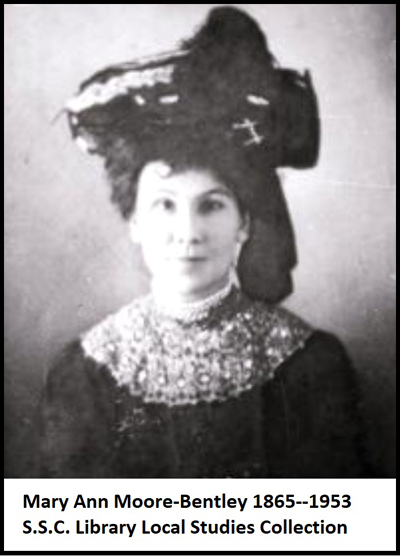

Writer and Parliamentary Candidate (also known as
Mary Ling)
Mary Ann Moore-Bently
was born on 6 January 1865 at Curradax farm, north of Braidwood, New
South Wales. She was one of the five children of English migrant, George Bentley
who married Mary Ann Moore in Sydney in 1852. After settling in Braidwood they
joined the Braidwood Mechanics Institute, subscribed to religious and secular
journals and observed Wesleyan Methodist religious practices. Mary and her two
younger brothers Charles (1867-1939) and Cornelius (1870-1943) were mainly
educated at home by their mother.
Mary’s father tried dairy farming unsuccessfully on
various properties around Braidwood and then gold mining near Temora. By 1880 he
had given up and the family moved to Marrickville where Mary Ann became a
nursemaid in the household of Colonel Charles Roberts. On 3 September 1889, she
married postal clerk Henry Hill Ling (1864-1942) at the Salvation Army Barracks
in Burwood. They separated in 1897 and divorced in 1906.
Mary Ann became a writer of poems, short
stories, fact and fiction. In 1890 her first novel was rejected by a London
publisher but in 1901, A Woman of Mars
or Australia’s Enfranchised Woman was
published in Sydney. She joined the Sydney Single Tax League and was appointed
to its executive council. A follower of Henry George an American political
economist and journalist, she promoted his views in her
Sketched from Life published in 1903.
The Commonwealth Franchise Act 1902
enabled women to vote at federal elections and also stand for election to the
Australian Parliament. In the Commonwealth elections of December 1903 women were
to vote for the very first time. Mary joined the Women’s Social and Political
League and as Mary Ann Moore-Bentley became one of four women who stood for
election to the Senate along with Nellie Martel, Vida Goldstein and Selina
Anderson. Although unsuccessful, they were the first women in Australia and the
British Empire to stand for National Parliament. Vida Goldstein stood for the
Senate again in 1910, 1913, 1914 and 1917 without success.
During the campaign, Mary described herself as ‘the working woman’s
candidate….a democrat first’. She believed the only tax should be on land
values, supported free trade, and advocated for the abolition of state
parliaments and the establishment of a state bank.
By 1906 Mary was living at Bangor, near Menai, although relations with
her brothers Charles and Cornelius, who lived nearby, were becoming tense.
She continued to write and in January 1917 her
A Psychological Interpretation of the
Gospel was published in Boston, USA. Later that year she sailed to America
hoping to obtain a publisher for An
Original Hypothesis of the Origin of Life. Failing to do so, she sought
assistance to return to Australia and had to be repatriated at government
expense.
Mary
retired to Menai and concentrated on writing childrens stories, poems and a
fortnightly journal something to Amuse.
In 1943 she was committed to the Mental Hospital at Stockton in Newcastle
where she died on 1 September 1953. She was buried in Stockton Cemetery with
Methodist rites. Her memoir Journey to
Durran Durra 1852-1885 written about 1935 was published in 1983.
Colleen Passfield 2018
To learn more about the family of Mary Ann Moore-Bently click on
the name at the heading of this article and you will be taken to Mary Ann's
entry in the Family Tree databsae.
References:
-
Wikipedia
-
Australian Dictionary of Biography
-
Ancestry
-
NSW BDM
-
Australian Electoral Rolls
-
National Library of Australia – Resources by Mary Moore -Bentley
-
Preface to Journey to Durrun Durra
-
Pioneer Women Hall of Fame
-
The Geelong Advertiser
19/11/1903
-
Truth (Sydney)
22/5/1904
-
The Sydney Morning Herald
16/3/1906


